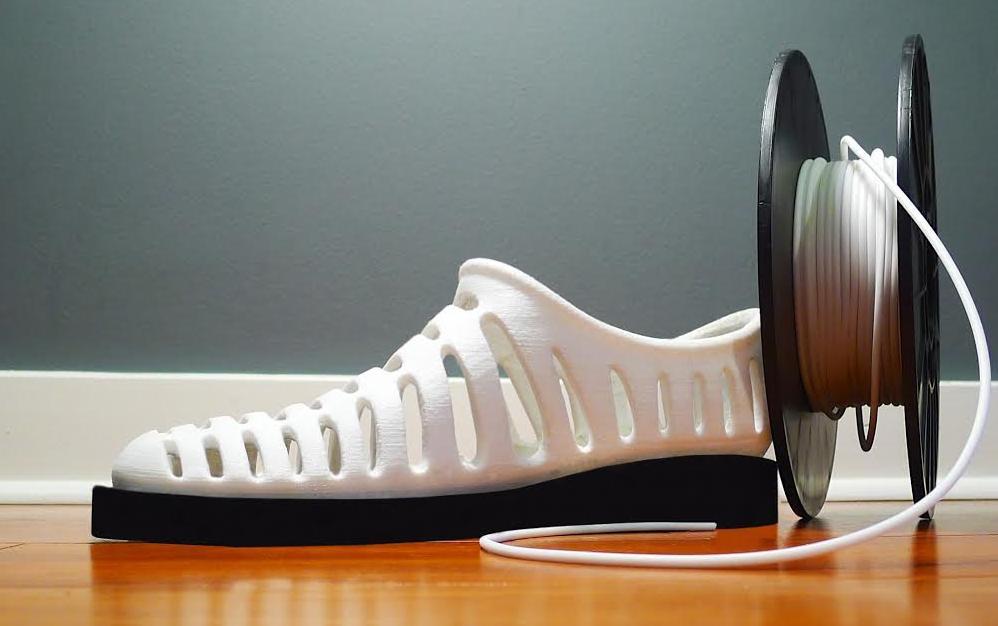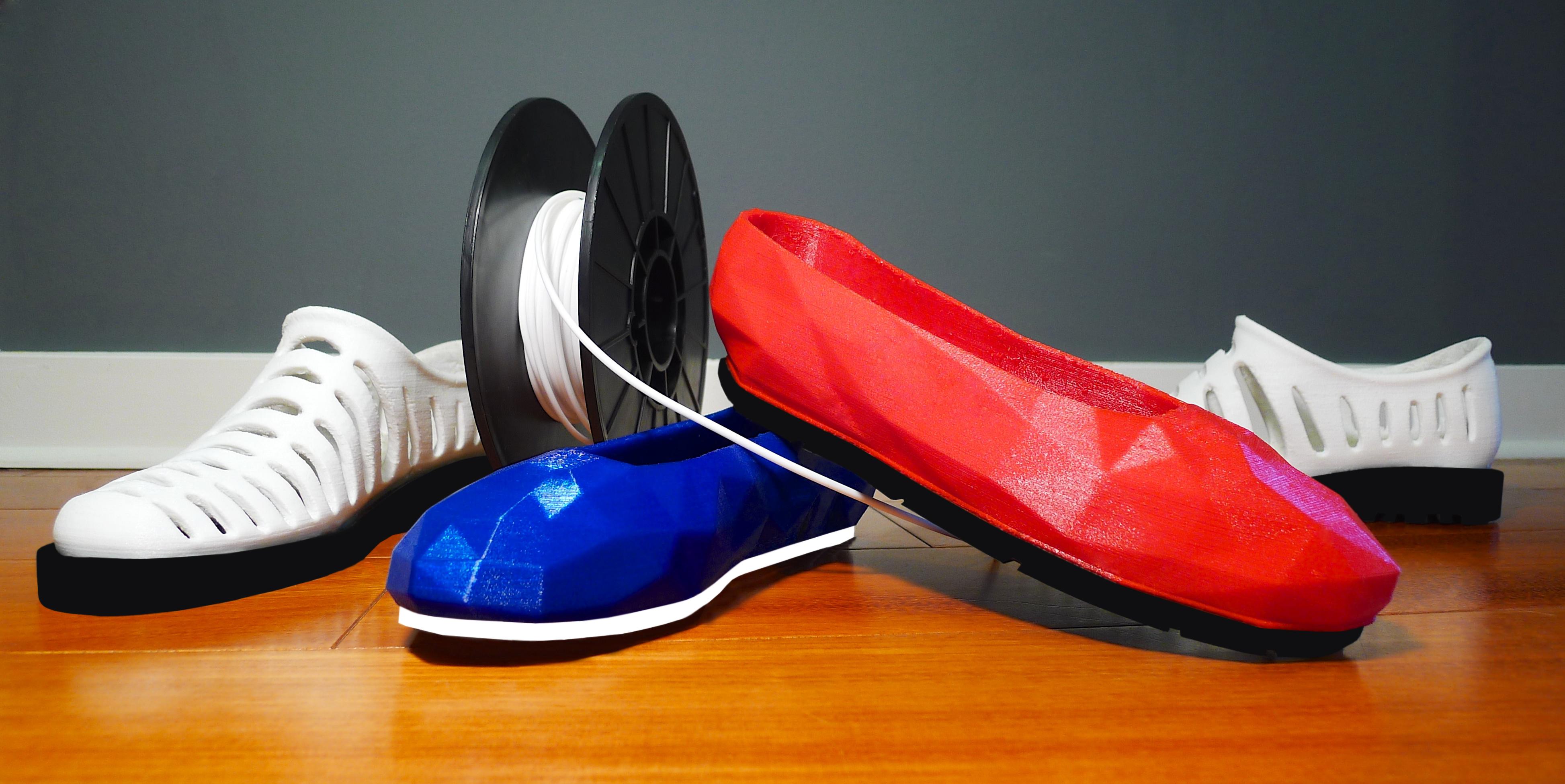Feetz CEO, Lucy Beard Details Plans for Their 3D Printed SizeMe Shoes – Coming to market this Christmas, starting at $200
 Back in April, when I was attending the Inside 3D Printing Conference & Expo in New York City, I had a chance to listen to a woman named Lucy Beard, pitch her idea of 3D printed shoes, to the hoards of people in attendance. Beard, the founder and CEO of Feetz, seems to have a confidence about her, that not many of the other speakers had. She knew what her goals were, and how to go about pitching her idea.
Back in April, when I was attending the Inside 3D Printing Conference & Expo in New York City, I had a chance to listen to a woman named Lucy Beard, pitch her idea of 3D printed shoes, to the hoards of people in attendance. Beard, the founder and CEO of Feetz, seems to have a confidence about her, that not many of the other speakers had. She knew what her goals were, and how to go about pitching her idea.
I must admit however, that when I first heard that she had planned to 3D print custom shoes, I was a bit skeptical to say the least. Then when she mentioned that she would be using consumer level FDM based 3D printers to do so, I almost began to tune her out. The idea of printing out a single pair of shoes on one’s own 3D printer at home, is not something that is all that simple to do, nor even slightly faster than a snail trying to walk through peanut butter. At least those are the thoughts that ran through my mind. Beard wanted to do this on a massive scale, while making sure that her customers could receive their shoes in a timely manner.
I had the chance to talk with Beard, as we walked around the expo, looking at the different 3D printers. During this time, I went from being a skeptic, to thinking that this idea could actually work. Was I becoming as crazy as I initially thought she was, or had this woman come up with a business plan that could make Steve Jobs look like an amateur?
Beard recently took some time out of her extremely busy schedule to chat with me about some of the latest news surrounding Feetz, as well as answer questions that had remained unanswered.
The thing that made me most skeptical about Feetz, while listening to Beard’s original pitch, was the fact that she planned on printing thousands of individual shoes on consumer level 3D printers. I immediately imagined a warehouse with 1000 Makerbot printers, each printing one pair of shoes a day. It just didn’t seem feasible.
However, Beard’s business plan is much more sophisticated and detailed than a simple warehouse full of MakerBot Replicators. I asked her if she was really planning on printing shoes on FDM based 3D printers.
“Yes, but we are making a custom hardware solution this summer to adapt to some of our specifics,” explained Beard. At MakerFaire we had the Airwolf printer going all weekend making shoes….. people loved to see it up close.”
She then went on to explain to me that instead of having a central location for manufacturing, they plan on setting up “manufacturing pods”, which will be located all over the world, based on where the most demand for these 3D printed shoes exists.
“It’s like the farm-to-table movement, where food is made locally [for] you, but in this case your footwear is made locally [for] you – creating jobs in your local economy, and it contributes to a lower carbon footprint (less shipping from 1 single worldwide location),” explained Beard.
She then went on to explain to me that they also are considering utilizing partners who can offer distributed 3D printing services. “We ‘rent’ time, so that printers don’t sit idle, and [this] allows us to ramp up and down with demand very easily” she explained.
So, perhaps my original vision of how Feetz was going to go about manufacturing thousands of shoes on FDM based printers was way off. The company seems to have a very comprehensive plan put in place, that seems to be able to actually make this a reality. Initially, Feetz plans on launching with 1 manufacturing pod located in Tennessee, consisting of a maximum of 20 3D printers, which will make a total of 1,000 pairs of shoes per month. After the launch of this pod, Beard and team will follow the demand curve to determine the next locations. “If all the shoes come form Colorado, we go there next,” said Beard.
The 3D printers that will be utilized will be able to print between 1 and 4 shoes at a time. “We don’t have just 1 type of printer because they have specific things that they are better at, such as bed size, material flexibility, and reliability,” she added.
Current shoes that most of us wear consist of approximately 65 parts and 13 different materials. In order for Feetz to be successful, this has to be simplified quite a bit. They are currently aiming to have only 3 different materials and 5 separate parts in their 3D printed shoes. However, Feetz plans on making custom blends of material for their 3D printers, which are based on already proven materials that work on these printers, such as plastics, rubbers, and nylons.
So, why 3D print shoes?
“The ability for 3D printers in controlling every layer – and hence creating material mimicry by printing techniques – means we can disrupt the current method of shoe manufacturing,” explained Beard.
 Feetz’s shoes will be called ‘SizeMe’ because as Beard explains, “In the future you will never get asked ‘what size shoe are you?’, as it will always be ‘SizeMe’.”
Feetz’s shoes will be called ‘SizeMe’ because as Beard explains, “In the future you will never get asked ‘what size shoe are you?’, as it will always be ‘SizeMe’.”
SizeMe shoes will be custom made per individual. The minimum price for a SizeMe shoe will be $200, and the company plans on targeting value towards consumers that currently wear orthotics, or struggle to find shoes that fit them. As Beard points out, approximately 2% of newborns are born with an extra toe, and 6% of men wear shoes over size 11.
“It’s kind of like we are doing what iTunes did for music,” explained Beard. “They created the platform for the long tail of music, to be readily available.”
Shoes today are not customizable at all. You walk into a store and find your size (both feet must be the same size) and buy whichever ones appeal to you the most. Unfortunately this leaves a huge percentage of people wearing shoes that simply are not comfortable. On top of this, many of these ‘unfitted’ shoes can cause more harm than good. They can throw the alignment of your body out of whack, and cause stress related injuries.
The customization process of Feetz is a simple, yet very effective one. The platform will allow customers to download an app on their smartphone or tablet, take photos of their foot in different positions, design a shoe that appeals to them, and then pay. That’s how simple the process is. Customization allows buyers to provide data such as their height, weight, and other lifestyle preferences. They can choose between different types of shoes, such as a walking shoe or sandal, and even customize the shape of the shoe’s toe (round, boxed, pointed, etc.). Once ordered, the shoes will be at the customer’s door within 7 days. How is that for turnaround time?
Feetz is now taking sign-ups for their Beta program, which will begin next month. People can sign up by visiting the Feetz website, and entering their email address. Beta customers will get to decide which types of shoes Feetz ends up launching with.
In Quarter 1 of 2015, Feetz has plans to offer their services in stores around the US. They are starting with a few stores such as 3D Heights in NYC, and then plan on expanding to standard footwear stores, boutiques, and medical shoe stores, as well as 3D printer stores.
Beard said that they want to get 1,000 pairs of shoes out to customers by this Christmas. Could this be the future of footwear? I am no longer as skeptical as I originally was. I’ll be the first in line for a pair of SizeMe shoes.
Discuss Feetz’s plan to bring customized 3D printed shoes to the masses in the Feetz discussion thread on 3DPB.com
Subscribe to Our Email Newsletter
Stay up-to-date on all the latest news from the 3D printing industry and receive information and offers from third party vendors.
You May Also Like
Precision at the Microscale: UK Researchers Advance Medical Devices with BMF’s 3D Printing Tech
University of Nottingham researchers are using Boston Micro Fabrication‘s (BMF) 3D printing technology to develop medical devices that improve compatibility with human tissue. Funded by a UK grant, this project...
3D Printing Webinar and Event Roundup: April 21, 2024
It’s another busy week of webinars and events, starting with Hannover Messe in Germany and continuing with Metalcasting Congress, Chinaplas, TechBlick’s Innovation Festival, and more. Stratasys continues its advanced training...
3D Printing Webinar and Event Roundup: March 17, 2024
It’s another busy week of webinars and events, including SALMED 2024 and AM Forum in Berlin. Stratasys continues its in-person training and is offering two webinars, ASTM is holding a...
3D Printed Micro Antenna is 15% Smaller and 6X Lighter
Horizon Microtechnologies has achieved success in creating a high-frequency D-Band horn antenna through micro 3D printing. However, this achievement did not rely solely on 3D printing; it involved a combination...































